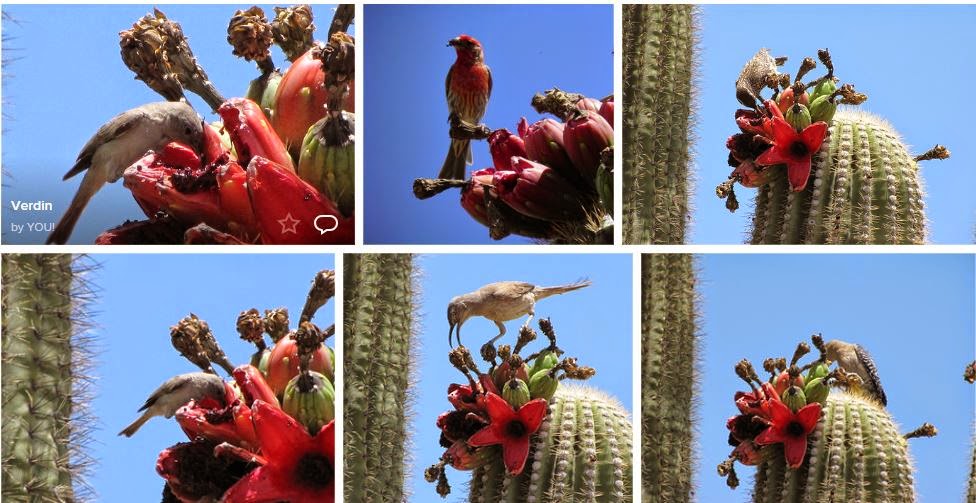Since then the fruits on our 'House Saguaro' first blushed on the outside, then split open and revealed their signal red inside: ripe! Birds, come and get sweet pulp and seeds! For weeks this bounty (and 2014 seems to be a particularly good year) has been a steady source of nutrition for the resident animals and entertainment for us.
Tiny Verdins and families of House Finches regularly gorged themselves, Cactus Wren and Curved Bill Thrasher parents were feeding their fledgeling young. Gila Woodpeckers and Gilded Flickers were too shy for good photographs this year, but noisily announced their presence while peaking around from the back.
A Mourning Dove and a White Winged dove actually moved into the big cactus, their nests not even two feet apart but separated by one of the massive arms. By now the first set of chicks has flown out and the White Wings have started another batch of eggs.
Even a pair of ravens brought 4 youngsters around, causing the other birds to break into loud, angry mobbing. The fruits are surprisingly sturdy, safely supporting those huge birds. The tall columnar cacti firmly hold onto their fruit, even after they are ripe and split open. Why?
The saguaro relies on zoochory (seed dispersal by animals) and especially on the dispersal by birds.
Birds have great color vision and can easily reach the top of the saguaro. The spontaneous splitting of the tough skin allows them access. They devoure the sweet pulp with the seeds, fly good distances, and then excrete the unharmed seeds.
 |
| Photo by Rich Hoyer |
After the birds had their turn, the fruits are finally falling and landing on the ground with an audible plop. The star-shaped hulls usually still contain enough seeds and pulp to attract some hungry quail that don't like the height of the saguaro top and many ants, flies, flightless beetles and rodents.
So the food chain of the desert floor is set into motion. Soon photo-shy Tiger Whiptails arrive to hunt for insects.
 |
Our resident rattler seems to patrol at least once a day. Who knows what goes on at night when the packrat collects the hard dry hulls to decorate her nest? Coyotes and bobcats are hanging around more than usually. The opportunistic coyotes will of course take the dinner as well as the diners. Jan Emming showed in a facebook post that canines can be pretty efficient seed dispersers. |
 |
| The packrat takes empty hulls and dry flower stalk to its midden |
 |
| At dusk I surprised a Cottontail and a Mourning Dove snacking on the sweet stuff |
 |
| Stella Tucker harvesting Saguaro fruit. Watercolor |
Years ago Stella Tucker, a Tohono O'odam story teller and historian, showed me how the long collecting pole is used and I found out how hard it is to dislodge the fruits before their time. In my painting Stella is holding the saguaro rib, and the back of her shirt is patterned with petroglyphs depicting the harvest.










Some great shots Margarethe. Love the cottontail one!
ReplyDeleteThat red color is just delicious! I always learn so much from you about life in the desert.
ReplyDelete